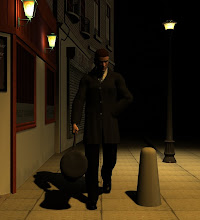Of course, in the era of Young – or nowadays, not so Young – British Artists, this shouldn't have mattered too much. Perhaps Damien Hurst or Tracy Emin can't sketch anything more sophisticated than a sun with a smiley face either, and this has never slowed them down. However, these were never the people who inspired me. I have never wanted to pickle sharks or fill houses with concrete, except for laughs. I was always drawn to the serious realists. Caravaggio, Manet, Rembrandt, Hopper, with their pitiless, often cruel depictions of alienation, pride and suffering. Put a mirror to the world, never mind whether or not it enjoys the experience. There was just the small drawback that I couldn't build the mirror.
So, as tends to be my response to any problem nowadays, I turned to computers and the internet. For some time I was aware of three dimensional modelling programs, where the software does most of the serious work and you are left free to tinker around. Or, to put it slightly more charitably, you provide the inspiration and your computer the perspiration. The brand leader is called, rather aptly, Poser. It costs a hilarious amount of money. I was trying to work out how to justify a purchase to my bank balance and soul when I stumbled across a cut-price version called Daz Studio. So cut-price, in fact, that the basic software is free.
This is of course a cunning marketing ploy rather than an act of benevolence by Daz. You end up buying so many add-ons and appliances to get that software to do anything whatsoever that the eventual spend is itself fairly hilarious. But you can't the stuff with you, I suppose. And now I can claim to have one more string on my creative bow. I can study a Brueghel and plan how to rip him off. I can pretend to be an artist.




